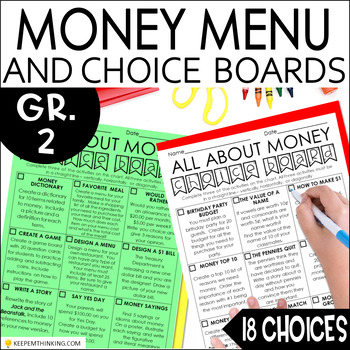Money Enrichment Activities | Math Menu | Choice Board | Tic-Tac-Toe
- Zip
Also included in
- Ditch the worksheets and enhance and extend the textbook with these four low prep money resources. From money games, task cards, and warm-ups to choice boards and more, this bundle is the one-stop resource you need to differentiate and teach money to your 2nd graders. You'll find everything you needPrice $9.50Original Price $18.95Save $9.45
Description
50% OFF 48 HRS! No Prep - Just Print and Go! Challenge your students in grades 2-3 with 18 different choices of highly engaging activities to demonstrate understanding of Money. These activities are available in 2 formats - Math Menu, or Choice Board format. They are intended as enrichment, replacement, or extension activities for fast finishers, high achievers, or gifted students.
There are printables included to include each activity to help students develop incredible products. They give students criteria, or things to think about when creating their products. There are a variety of activities included which will appeal to different learning styles and interests.
THIS RESOURCE INCLUDES:
⭐ 18 Cards (4 to a page) two styles available with Menu Headers or Without the Category
⭐ Large Header Cards for Appetizers, Main Dish, Side Dish, and Desserts
⭐ Two Tic-Tac-Toe Boards
⭐ Instruction pages with criteria or things to think about for each product.
WAYS YOU CAN USE THESE RESOURCES:
✅ In a center/station
✅ Independent activities for Fast Finishers
✅ Replacement activities for students who have already mastered the grade level standards for Money
✅ For Early Finishers – have cards in an early finisher center
✅ For homework
© Susan Morrow This purchase is for single classroom use only. Sharing this resource with multiple teachers, an entire school, or an entire school system is strictly forbidden. Multiple licenses are available at a discount.
CLICK HERE TO FOLLOW MY STORE to be the first to get updates and news!
*****************************************************************************************************
BELOW ARE LINKS TO MY OTHER PRODUCTS YOU MIGHT BE INTERESTED IN:
*****************************************************************************************************
MONEY MATH WARM-UPS AND NUMBER TALKS
COUNTING MONEY JEOPARDY STYLE GAME SHOW
Remember to always … Keep 'em Thinking!
Susan Morrow






